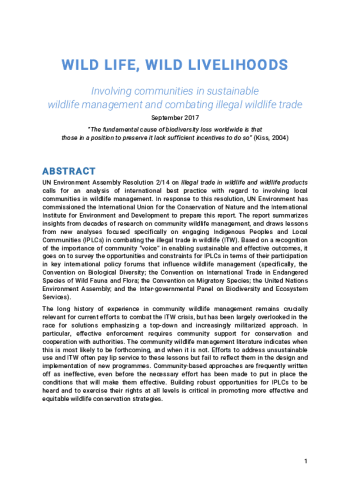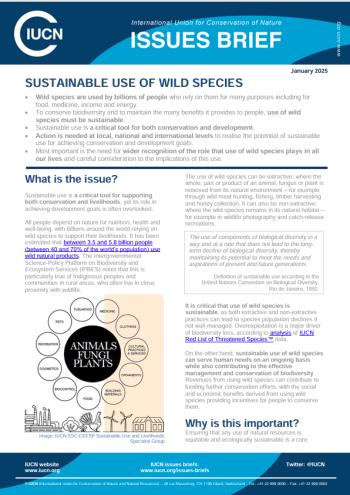
WILD LIFE, WILD LIVELIHOODS: Involving Communities in Sustainable Wildlife Management and Combating Illegal Wildlife Trade
This report responds to Resolution 2/14 passed at the second meeting of the United Nations Environment Assembly in May 2016, calling for “...an analysis of international best practices with regard to involving local communities in wildlife management as an approach to addressing the unsustainable use of and illegal trade in wildlife and wildlife products[...]”.
The report summarizes insights from decades of research on community wildlife management, and draws lessons from new analyses focused specifically on engaging Indigenous Peoples and Local Communities (IPLCs) in combating the illegal trade in wildlife (ITW). Based on a recognition of the importance of community “voice” in enabling sustainable and effective outcomes, it goes on to survey the opportunities and constraints for IPLCs in terms of their participation in key international policy forums that influence wildlife management (specifically, the Convention on Biological Diversity; the Convention on International Trade in Endangered Species of Wild Fauna and Flora; the Convention on Migratory Species; the United Nations Environment Assembly; and the Inter-governmental Panel on Biodiversity and EcosystemServices).
Cooney, R., Roe, D., Dublin, H. and Booker, F. (2018) Wild Life, Wild Livelihoods: Involving Communities in Sustainable Wildlife Management and Combatting the Illegal Wildlife Trade. United Nations Environment Programme, Nairobi, Kenya
Resource
We support the free flow of information. Please share:
Form coming soon
Related Content
-

-

Review of African Social and Economic Development Volume 1
ByIbrahim Bàbátúndé Anobaarrow_forward2024 -

Economic Analysis: Climate Change and Wildlife Utilization on Private Land
ByJackson OtienoEdwin Muchapondwaarrow_forward2015
Get updates by email
Through impactful research, stakeholder engagement, and professional development, AWEI is supporting the wildlife economy across Africa. Please subscribe for occasional updates on our work and forthcoming events.
Sign up for a quarterly dose of AWEI insights
In a complex and changing world, AWEI generates strategic ideas, conducts independent analysis on wildlife economies, and collaborates with global scholar-practitioners to provide training and expertise for biodiversity conservation, climate resilience, and inclusive economic opportunities in Africa.
